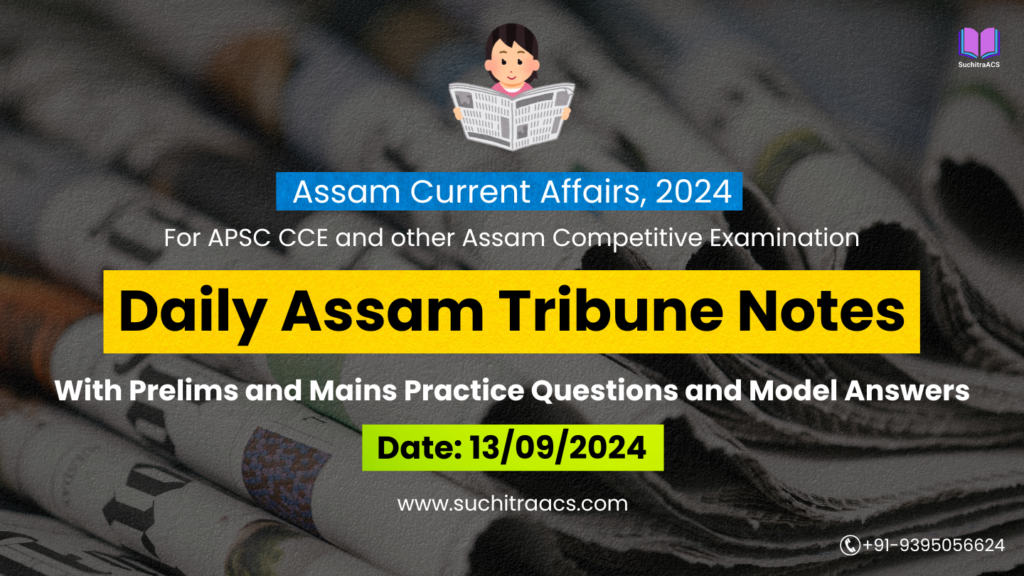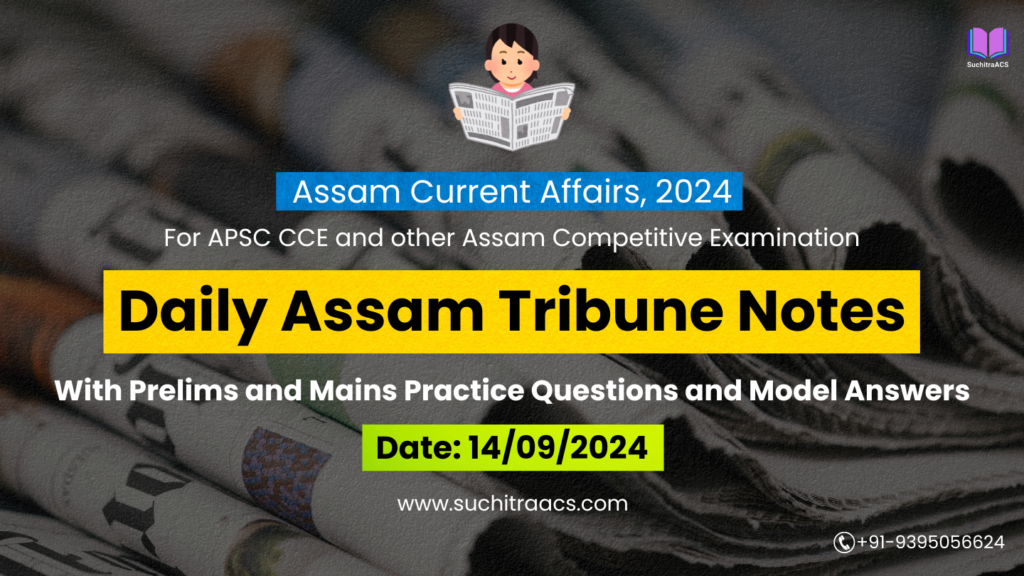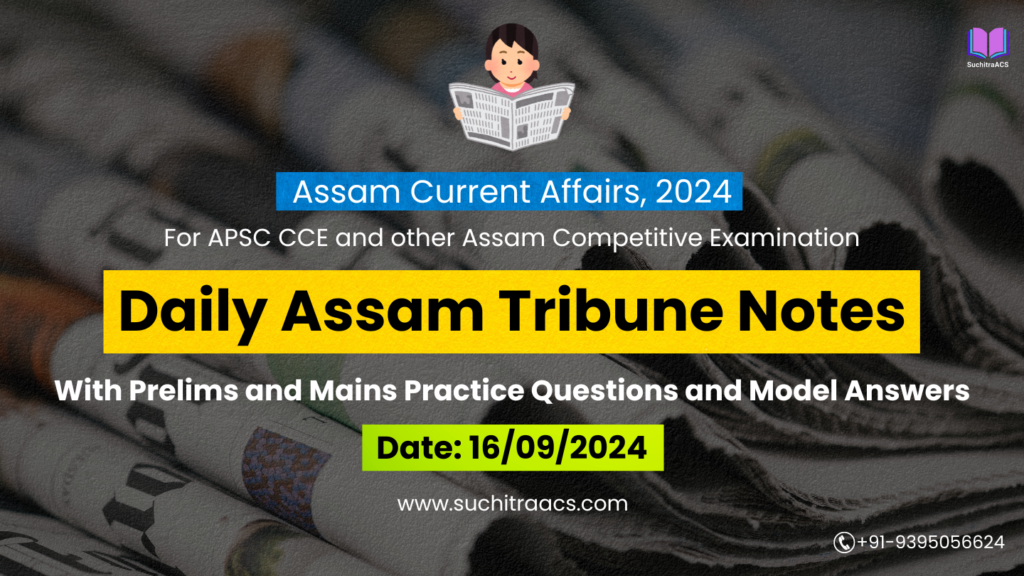APSC Current Affairs: Assam Tribune Notes with MCQs and Answer Writing (29/05/2025)
For APSC CCE and other Assam Competitive examinations aspirants, staying updated with current affairs is vital. This blog covers most important topics from the Assam Tribune today (29-05-2025). These issues are key for both APSC Prelims and Mains preparation, offering insights into the APSC CCE Syllabus.
✨ APSC CCE Online Coaching, 2026
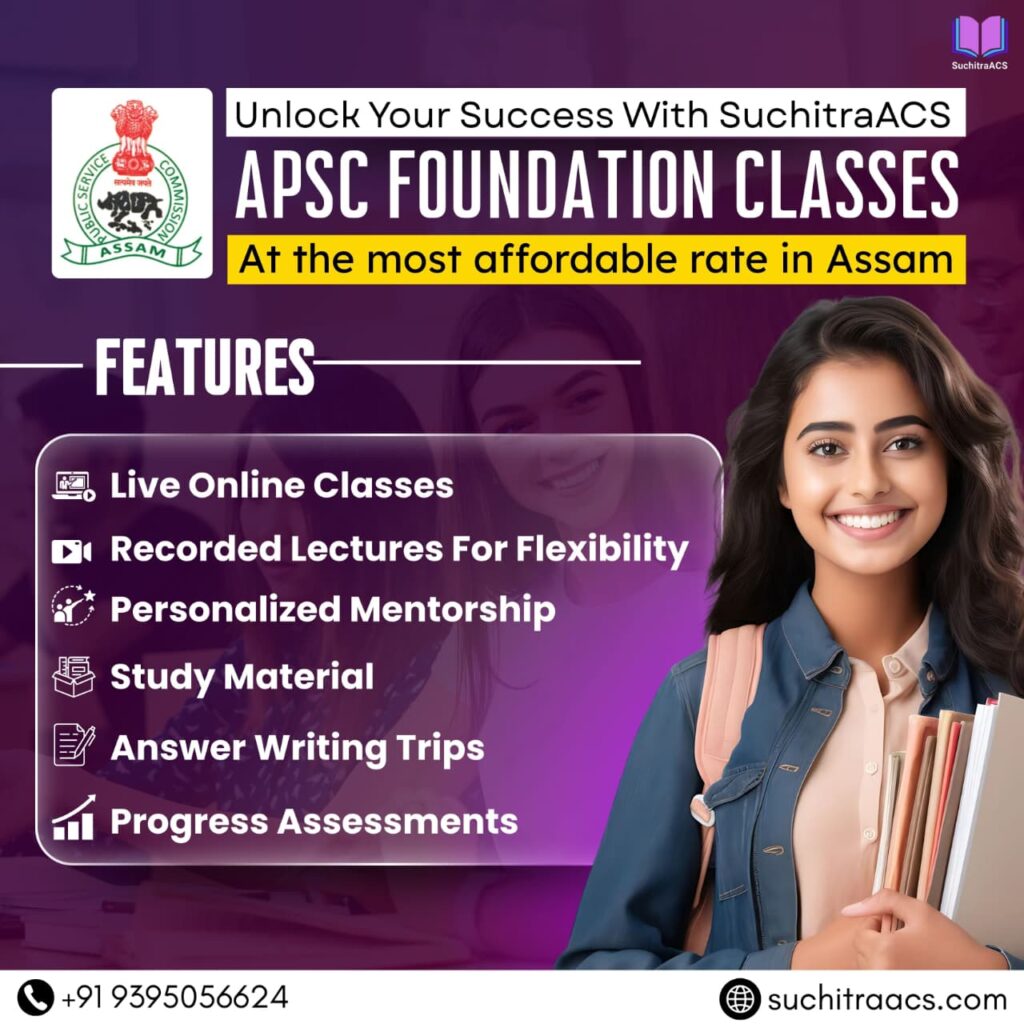
🛡️ Arms Licences for Indigenous Citizens in Vulnerable Areas of Assam
📘 GS Paper 2: Governance | Government Policies & Interventions
📘 GS Paper 5 (APSC): Polity, Governance, and Security Issues in Assam
🔹 Introduction
In a recent decision, the Assam Cabinet approved a new scheme to issue arms licences to indigenous citizens living in vulnerable, remote, and border areas. The scheme is framed as a response to long-standing security concerns among indigenous populations who face threats from unlawful elements and demographic pressures.
🔑 Key Points
| Feature | Details |
| Scheme Name | Special Scheme for Grant of Armed Licence to Indigenous Citizens |
| Announced By | CM Himanta Biswa Sarma |
| Target Beneficiaries | Original inhabitants in vulnerable areas (e.g., Dhubri, Goalpara etc.) |
| Legal Basis | Arms Act – Licences issued after antecedent verification |
| Rationale | Address threats to life, land, and property |
⚙️ Policy Objectives
Enhance security for indigenous communities in border and interior areas
Prevent land alienation caused by threat perceptions
Empower legal and responsible arms ownership among vulnerable citizens
🧠 Prelims Pointers
Arms Act, 1959: Regulates acquisition and possession of firearms in India.
Vulnerable Areas (Assam): Often near international borders; prone to demographic changes.
Assam Cabinet: Executive decision-making body chaired by the CM.
Article 29 & 30: Safeguards rights of minorities and indigenous communities.
Dhubri, Goalpara, South Salmara: Districts flagged for indigenous insecurity.
📝 Mains Pointers
A. Importance of the Scheme
Protects identity and land rights of indigenous citizens
Boosts confidence in law enforcement and government responsiveness
Acts as a deterrent against illegal encroachment and extortion
Recognizes the geo-political sensitivities of border districts
B. Challenges
| Challenge | Explanation |
| Misuse of Licences | Risk of firearms being used for personal vendettas or communal tension |
| Verification and Oversight | Complexities in verifying antecedents in remote areas |
| Legal and Human Rights Concerns | Potential for criticism if used against specific communities unfairly |
| Arms Proliferation | Risk of increasing civilian armament in a sensitive state |
C. Government Initiatives
Licences issued only after strict verification
Scheme backed by Cabinet approval, to be formally notified
CM has flagged this as a corrective measure for past inaction
Intended as a preventive step, not a reactionary one
D. Way Forward
🔍 Ensure stringent screening and renewal process for arms licences
🤝 Engage civil society and local leaders for community-based monitoring
📚 Create awareness programs on arms laws and responsible ownership
🧾 Establish a transparent grievance redressal mechanism
📊 Periodic review to ensure the policy achieves security without unrest
🧩 Conclusion
The arms licence scheme marks a bold, though controversial, attempt to address deep-rooted insecurities among Assam’s indigenous communities. While it aims to restore confidence and protect rights, its long-term success will hinge on careful implementation, strict regulation, and continuous dialogue with all stakeholders to balance security with harmony.
⚖️ Supreme Court Orders Probe into Alleged Fake Encounters in Assam
📘 GS Paper 2: Governance | Role of Judiciary | Human Rights
📘 GS Paper 5 (APSC): Governance, Law and Order, Human Rights in Assam
🔹 Introduction
The Supreme Court of India has directed the Assam Human Rights Commission (AHRC) to probe over 171 alleged police encounters that took place in Assam between May 2021 and August 2022, following allegations of procedural violations and extrajudicial killings. This marks a significant moment for accountability and rule of law in the State’s law enforcement framework.
🔑 Key Points
| Feature | Description |
| Authority Involved | Supreme Court of India |
| Investigation Body | Assam Human Rights Commission (AHRC) |
| Time Frame of Encounters | May 2021 – August 2022 |
| Number of Cases | 171 incidents flagged, 56 deaths (including 4 custodial), 145 injured |
| Petition Filed By | Arif Md Yeasin Jwadder (Human Rights Activist) |
| Directives by Court | Ensure fair hearing, confidentiality, and legal aid to victims’ families |
| Guidelines Referenced | 2014 SC Guidelines (PUCL vs Maharashtra case) on encounter investigations |
🧠 Prelims Pointers
PUCL vs State of Maharashtra (2014): Landmark SC ruling laying out 16-point guidelines for police encounter investigations.
Assam Human Rights Commission (AHRC): Established under Protection of Human Rights Act, 1993 (State-level body).
Fake Encounter: A staged or extrajudicial killing by law enforcement without judicial oversight.
Assam State Legal Services Authority (ASLSA): Directed to provide legal aid to families of victims.
Article 21 of the Constitution: Protection of life and personal liberty.
📝 Mains Pointers
A. Importance of Judicial Oversight
Reinforces constitutional safeguards like due process and right to life.
Promotes transparency and accountability in police operations.
Encourages institutional checks and balances in a democracy.
Strengthens citizen trust in the justice delivery system.
B. Challenges in Encounter Cases
| Challenge | Explanation |
| Lack of Independent Probes | Police often investigate their own actions, leading to bias |
| Political Encouragement | Public statements promoting “tough policing” dilute accountability |
| Fear of Demoralization | Policemen claim judicial scrutiny hampers their morale |
| Weak Institutional Mechanisms | Delay in setting up special investigation teams (SITs), NHRC/AHRC under-resourced |
C. Govt. Initiatives & Court Measures
SC entrusts AHRC, headed by a retired HC Chief Justice, with probe
Public notices to be issued for affected families to submit claims
Confidentiality ensured for complainants to prevent intimidation
SC ordered Assam government to remove all institutional barriers to the probe
Legal aid directed through Assam State Legal Services Authority (ASLSA)
D. Way Ahead
🕊️ Balance security with human rights – law enforcement should respect legal protocols
🔍 Establish independent Special Investigation Units (SIUs) for encounter probes
📊 Maintain a public database of encounter cases for transparency
📚 Train police in rights-based and community-centric policing
🧾 Ensure prosecution of guilty officers where violations are confirmed
📑 Related Policies & Reports
NHRC Guidelines on Encounters (2010)
Second ARC Report on Public Order (2007)
Code of Criminal Procedure (CrPC) Sections 46, 49, 100, 176 – relevant for police action and investigation
UN Basic Principles on the Use of Force and Firearms by Law Enforcement Officials (1990)
🧩 Conclusion
The Supreme Court’s directive is a reminder that law must remain above the law enforcer. While policing in insurgency-prone states like Assam requires firmness, it must always operate within constitutional and legal boundaries. An impartial and timely inquiry can restore public faith, ensure justice for victims, and set a strong precedent for accountability across the nation.
🍃 Influx of Low-Quality Tea Imports: A Threat to Assam’s Tea Industry
📘 GS Paper 3: Economy – Indian Agriculture | Industrial Policy
📘 GS Paper 5 (APSC): Assam Economy | Agriculture & Allied Sectors | Tea Industry
🔹 Introduction
Industry representatives in Assam have raised concerns about the influx of cheap, low-quality tea imports, particularly from Vietnam, Iran, and Africa. These teas are being re-exported deceptively as “Indian Tea” or entering the domestic market, undermining Assam’s globally respected tea industry. The issue was discussed during a Parliamentary Standing Committee on Commerce meeting in Guwahati, highlighting regulatory lapses and long-standing structural vulnerabilities.
🔑 Key Points
| Feature | Description |
| Parliamentary Panel Visit | Headed by MP Dola Sen, met with producers, exporters & labour officials |
| Key Concern | Import of cheap duty-free teas rebranded and re-exported as Indian Tea |
| Tea Import Surge | 85% increase in imports from Kenya in last 3-4 years |
| Domestic Impact | Tea prices falling despite production shortfall in 2024 |
| Major Demands by Industry | Fix Minimum Import Price (MIP); Impose Anti-Dumping Duty; Regulate Imports |
| Issue with MRLs | Multiple Maximum Residue Limits (MRLs) across export markets |
⚙️ Economic & Social Impact
Undermines Assam’s tea brand reputation globally
Displaces domestic tea in the Indian retail market
Triggers price crash, hurting over a million tea workers and small growers
Affects export competitiveness due to perceived quality dilution
🧠 Prelims Pointers
Tea Board of India: Statutory body under Ministry of Commerce.
CTM (Certificate of Origin): Required for legitimate Indian tea exports.
MRL (Maximum Residue Limit): Limits on pesticide residues allowed in food exports.
Geographical Indication (GI): Assam Orthodox Tea has GI tag.
India’s Tea Imports Sources: Kenya, Vietnam, Iran, Africa.
Anti-Dumping Duty: Imposed when goods are imported at prices lower than their value in home market.
📝 Mains Pointers
A. Significance of Tea Industry in Assam
Assam contributes over 50% of India’s total tea output
Employs over 1 million workers, mainly women from tribal communities
Export hub – key revenue earner and cultural identity of Assam
Major source of livelihood for small tea growers (STGs)
B. Challenges Highlighted
| Challenge | Explanation |
| Tea Import Mismatch | Actual imports not matching official Tea Board data – underreporting feared |
| Misbranding as Indian Tea | Re-exports of cheap imports affect India’s brand in global market |
| Price Collapse | Oversupply and under-regulation causing distress to genuine producers |
| Quality Control | Lack of effective testing for residues, adulteration |
| Export Rejections | Inconsistent MRL standards across EU/US/Japan create trade barriers |
C. Government Initiatives
Tea Board mandated import declaration on its portal
Consultations with Ministries of Commerce and Agriculture
Encouraging lab testing infrastructure – NABL-accredited labs
Push for harmonization of MRLs with EU and US standards
Awareness campaigns for traceability and authenticity
D. Way Forward
📊 Fix Minimum Import Price (MIP) and impose quantitative restrictions
🛡️ Enforce strict anti-dumping duties on cheap tea imports
🧪 Harmonize MRL standards with key export destinations
📦 Ensure full traceability of origin for re-exported tea
🧾 Mandatory labeling and customs declaration for all tea imports
🤝 Promote Indian GI teas globally through branding & fair trade
📑 Reports & Policy References
Tea (Distribution and Export) Control Order, 2005
Vision 2030 – Tea Board Strategic Plan
WTO Rules on Dumping and Safeguards
APEDA Export Guidelines for Tea
Draft National Tea Policy (Proposed)
🧩 Conclusion
The unchecked influx of substandard tea poses a grave threat to Assam’s iconic industry—jeopardizing its global standing, domestic market, and the livelihoods of lakhs of people. Strategic policy action, trade safeguards, and regulatory vigilance are urgently needed to preserve Assam’s tea legacy and economic backbone.
APSC Prelims Practice Questions
🧩 Topic 1: Arms Licence Scheme for Indigenous People in Assam
1. Consider the following statements regarding the recent arms licence policy announced by the Assam government:
- It aims to provide arms licences to all citizens in Assam irrespective of area or background.
- The scheme targets indigenous people living in vulnerable and border districts.
- Licences will be issued under the Arms Act after verifying antecedents.
Which of the above statements is/are correct?
A. 1 and 2 only
B. 2 and 3 only ✅
C. 1 and 3 only
D. 1, 2 and 3
🧠 Explanation:
Statement 1 is incorrect as the scheme is selective, aimed at indigenous citizens in vulnerable and remote districts, not all citizens. Statement 2 and 3 are correct.
2. Assertion (A): The recent arms licence scheme in Assam is aimed at protecting indigenous communities from demographic and unlawful threats.
Reason (R): Indigenous communities in certain districts of Assam have expressed insecurity over land rights and physical threats.
Choose the correct answer:
A. Both A and R are true and R is the correct explanation of A ✅
B. Both A and R are true but R is not the correct explanation of A
C. A is true but R is false
D. A is false but R is true
🧠 Explanation:
The scheme is clearly based on long-standing demands from indigenous communities facing insecurity. R explains A well.
🧩 Topic 2: Supreme Court-Directed Probe into Alleged Fake Encounters in Assam
3. With reference to the 2014 Supreme Court guidelines on police encounters (PUCL vs State of Maharashtra), consider the following directives:
- Mandatory registration of FIR in every encounter death.
- Inquiry to be conducted by the same police station involved in the encounter.
- Mandatory magisterial inquiry for every custodial death.
Which of the above is/are correct?
A. 1 and 2 only
B. 1 and 3 only ✅
C. 2 and 3 only
D. 1, 2 and 3
🧠 Explanation:
Statement 2 is incorrect. The inquiry must be independent, not by the same police station. 1 and 3 are mandated by the SC.
4. Which of the following institutions have a statutory mandate under the Protection of Human Rights Act, 1993?
- National Human Rights Commission (NHRC)
- Assam Human Rights Commission (AHRC)
- National Legal Services Authority (NALSA)
Select the correct answer using the code below:
A. 1 only
B. 1 and 2 only ✅
C. 2 and 3 only
D. 1, 2 and 3
🧠 Explanation:
NHRC and state commissions like AHRC are created under this Act. NALSA is a separate body under the Legal Services Authorities Act, 1987.
5. Which of the following are provisions under Article 21 of the Indian Constitution?
- Protection against arbitrary arrest
- Right to privacy
- Right to shelter
- Right to life with dignity
Choose the correct code:
A. 1 and 2 only
B. 2 and 4 only
C. 2, 3 and 4 only ✅
D. 1, 2, 3 and 4
🧠 Explanation:
While Article 21 has been interpreted to include right to privacy, shelter, and dignity, arbitrary arrest is protected under Article 22.
🧩 Topic 3: Import of Low-Quality Tea and Threats to Assam’s Tea Industry
6. Match the following tea-producing countries with their concerns in Indian markets:
| Country | Concern |
| A. Vietnam | 1. Mismatch in MRL standards with Indian norms |
| B. Kenya | 2. Surge in imports creating oversupply |
| C. Iran | 3. Re-exported tea labeled falsely as Indian origin |
Select the correct match:
A. A-1, B-2, C-3 ✅
B. A-2, B-3, C-1
C. A-3, B-1, C-2
D. A-1, B-3, C-2
🧠 Explanation:
Vietnam’s tea has been flagged for MRL inconsistency, Kenya’s for import surge, and Iran for labelling violations.
7. Consider the following provisions related to international trade regulation of agricultural products:
- Anti-Dumping Duty
- Minimum Support Price
- Minimum Import Price
- Harmonization of MRLs
Which of the above are trade-related tools to protect domestic industry?
A. 1, 2 and 3 only
B. 1, 3 and 4 only ✅
C. 2, 3 and 4 only
D. 1, 2, 3 and 4
🧠 Explanation:
MSP is a domestic price support, not a trade tool. The others are used in regulating import/export trade.
8. Which of the following statements about the Tea Board of India is/are correct?
- It was established under the Tea Act, 1953.
- It functions under the Ministry of Agriculture.
- It is responsible for the certification and export promotion of Indian tea.
Select the correct code:
A. 1 and 2 only
B. 1 and 3 only ✅
C. 2 and 3 only
D. 1, 2 and 3
🧠 Explanation:
Statement 2 is incorrect. Tea Board is under the Ministry of Commerce & Industry, not Agriculture.
APSC Mains Practice Question
📝 Mains Question (GS Paper II – Governance | Law & Human Rights):
Q. The recent Supreme Court directive to the Assam Human Rights Commission to investigate alleged fake encounters underscores concerns about the accountability of law enforcement. In this context, discuss the constitutional and legal safeguards against extrajudicial actions by the State. Also examine the challenges in ensuring police accountability and suggest a way forward.
📘 Model Answer:
Introduction
The Supreme Court’s recent directive (May 2025) entrusting the Assam Human Rights Commission (AHRC) to investigate over 171 alleged police encounters in Assam (May 2021–August 2022) reignites the debate around police accountability and extrajudicial actions. While strong policing is essential for maintaining public order, the Constitution mandates that such actions must remain within the framework of rule of law.
Constitutional & Legal Safeguards Against Extrajudicial Actions
| Provision / Instrument | Explanation |
| Article 21 | Ensures the right to life and personal liberty; any deprivation must follow due process. |
| Article 22 | Provides protection against arbitrary arrest and detention. |
| CrPC Sections 46, 176 | Lay down the limits of use of force during arrest and mandate magisterial inquiry in case of custodial death. |
| SC Guidelines in PUCL vs Maharashtra (2014) | 16-point protocol for encounter investigations, including FIR registration, independent probe, magisterial oversight. |
| Protection of Human Rights Act, 1993 | Empowers NHRC and SHRCs (like AHRC) to inquire into human rights violations by public servants. |
| NHRC Guidelines (2010) | Require all encounter deaths to be reported within 48 hours for transparency and review. |
Challenges in Ensuring Police Accountability
- Political Patronage & Verbal Encouragement
- Public statements by political executives (e.g., “shoot below the knee”) may normalize aggressive policing.
- Lack of Independent Oversight Mechanisms
- Most encounter cases are investigated by the same police departments, creating a conflict of interest.
- Poor Implementation of SC Guidelines
- Despite the clear guidelines of 2014, many states (including Assam, as alleged) have flouted or delayed compliance.
- Public Sentiment & Media Narrative
- In high-crime zones, public may support ‘instant justice’, weakening demand for due process.
- Inadequate Resources for Human Rights Commissions
- Bodies like AHRC often lack manpower and funding for timely and credible investigations.
Way Forward
✅ Strengthen Institutional Oversight
- Empower independent units (under Lokayukta/Human Rights Commissions) to monitor and investigate police actions.
✅ Mandatory Compliance Reporting
- States must submit annual compliance reports on SC guidelines related to encounters.
✅ Police Reforms
- Implement Supreme Court directives in Prakash Singh vs Union of India (2006), including separation of law & order and investigation functions.
✅ Capacity Building and Human Rights Training
- Sensitize police forces on constitutional values, use of non-lethal force, and community engagement.
✅ Whistleblower & Victim Protection
- Ensure confidentiality and legal support for families and individuals who file complaints against illegal police actions.
Conclusion
While police forces face real threats and operational constraints, state legitimacy must rest on the rule of law, not on vigilante justice. The SC’s directive to the AHRC is a critical opportunity for corrective justice and democratic accountability. Upholding constitutional morality over expedient governance is the key to a just, secure, and rights-respecting society.
✨ APSC CCE Courses, 2025-26 offered by SuchitraACS
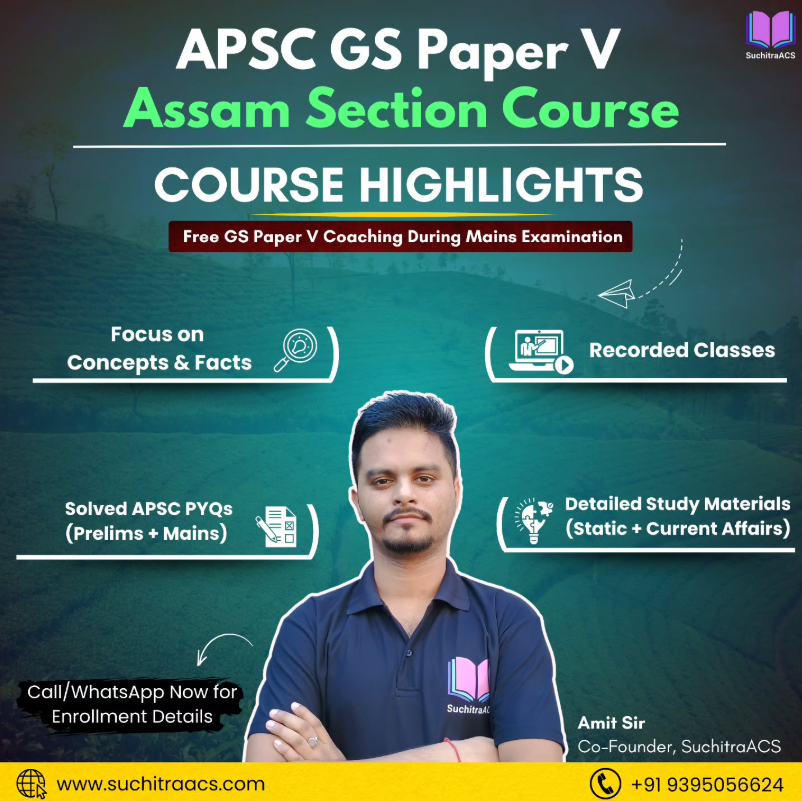

🔔 Join Our WhatsApp Study Group!
For exclusive access to premium quality content, including study materials, current affairs, MCQs, and model answers for APSC CCE and other Assam competitive exams.
Click here to join: SuchitraACS Study WhatsApp Group
📚 Want to know more about SuchitraACS’s most affordable courses?
Click here to know more: SuchitraACS Courses for APSC CCE and Assam Competitive Examinations


